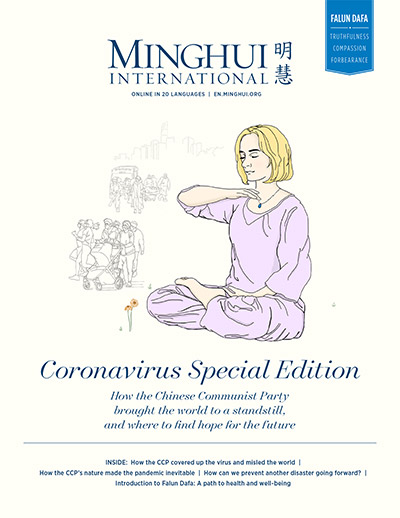Â
(Clearwisdom.net)Â
Physics is the leading force of the twentieth century. There are two pillars in modern Physics: Quantum theory and the theory of Relativity. The cellular phone and television that we use on a daily basis are directly tied to Quantum theory, while nuclear weaponry and nuclear power are intertwined with the theory of Relativity. Yet there is something that continually puzzles the physics community, and that is the incompatibility of the two theories. Quantum theory is based on probability and the theory of Relativity is based on determinism. Einstein had a difficult time accepting the probability explanation of the Quantum theory. He is famous for saying, "God does not throw dice." In order to solve the conflict between these two theories, in his later years, Einstein attempted to establish a unified theory to describe all forces in Nature. Many scientists later tried to develop "Grand Unified Theory" (a theory of everything) that was able to describe the entire universe. It has not succeeded because it has not been able to reconcile with gravity.
In 1998, astronomers discovered the accelerating expansion of the universe. This was opposed to the deceleration that the physicists expected. The new discovery was completely unexpected by modern physics and it led to the belief that there is a mysterious power (energy) that pushes the accelerating expansion of the universe and they named it "dark energy." From observing the current astronomy, 96% of the universe is made of "dark energy" (73%) and "dark matter" (23%). That which human beings are able to see and observe only adds up to 4%. The modern scientific understanding of the entire universe is extremely shallow.
The data ultimately shows that dark energy is tearing the universe apart with faster and faster speed and determines the fate of the universe. An article in Scientific American (February 2007) stated that dark energy is an invisible hand, which not only accelerates the expansion of the universe, but also has a strangehold on the shape and spacing of galaxies.
This accelerating expansion of the universe is the largest enigma of science of the twentieth century. It has made a huge impact upon science, in fact leading the community of physicists to face an immense challenge and crisis. Some physicists realize that the discovery of dark energy and matter is shaking the foundation of modern physics, forcing the need to develop new theories in physics.
During the last several decades, upon developing "Grand Unified Theory," its favored candidate is superstring theory. String theory believes the basic building block of matter is not a particle, such as electrons, photons, neutrinos or quarks, but very tiny closed strings, which are called closed loops or strings. Closed strings have different vibrations and movements which produce different particles.
In attempting to explain the accelerating expansion of the universe, superstring theory has not only added more dimensions besides the current three dimensions, it also hypothesizes untold numbers of parallel universes with different physical laws. It is believed that the big bang happened many times and created parallel universes. The universe we are in is one of those parallel universes. Many physicists believe the key issue is not whether parallel universes exist, but how many levels there are. Â Scientific American (May 2003) published an article called "Parallel Universes" which surveys four levels of parallel universes (multiverses).
The new explanation from superstring" theory supports the anthropic principle; that is that lives are able to exist in the universe because the combination of each and every fundamental constant produces an environment that suits life, otherwise the universe would not be this way and there would not be intelligent lives like us. An article in Science (11 August 2006) states the anthropic principle, which has caused huge controversy and led to a philosophical schism in the physics community. Some physicists believe it threatens the foundation of physics. The opposition believes it is more like philosophical research, not positivism. Advocates believe more and more evidence supports the anthropic principle. David Deutsch, theoretical physicist from Oxford University who invented quantum computer, believes logical positivism is a dead end, and a poison in science.
In summary, the Universe's accelerating expansion is challenging the scientific theory of spacetime. According to a report from New Scientist(10 December 2005), at the 23rd Solvay Conference in Physics in Brussels (December 2005), Belgium, David Gross, Nobel laureate from the Kavli Institue for Theoretical Physics at the University of California, Santa Barbara (UCSB), admitted, "We don't know what we are talking about". Physics is in "a period of utter confusion." The current physics might miss something fundamental. What is this something fundamental? Modern physics, the leading force of twentieth century science, has no idea.
Recently, Lisa Randall, a theoretical physicist from Harvard University, was listed as among the one hundred most influential figures in 2007 by Time magazine. Prof. Randall has developed a theory on extra dimensions beyond the three that we can see and feel. As a matter of fact, the idea of extra dimensions is not a new concept. Compared with string theory, her fifth dimension could be infinitely large. Time magazine reported that her most important work is the suggestion of ways to test for evidence of extra dimensions.
One of the focuses of physics research nowadays is the question of extra dimensions and other spacetimes (universes). The problem itself relates to how human beings understand the universe, spacetime and lives. Such issues have profound implications for our lives. The current positivism method has tremendous problems in researching this aspect. The "something fundamental " that is lacking in modern science can be found in ancient Chinese science and the cultivation community. Ancient Chinese science and the cultivation community have a distinctive and profound understanding of other spacetimes and life. For example, the /Book of Changes /(1), Taichi, five element theory, Chinese medicine meridians, even the worldly side-path practices such as fengshui (2) all focused on extra dimensions and other spacetimes. They began their study from the interaction of the extra dimensions with our visible and tangible dimensions. Only by getting rid of the positivism method and adopting new thought can we explore extra dimensions and other spacetime (universes), and the matter and life that exist there.
Notes:
(1) Book of Changes - an ancient Chinese book of divination dating from the Zhou dynasty (1100 B.C.-221 B.C.).
(2) fengshui (fuhng-shway) - Chinese geomancy, a practice of reading landscapes.
Â
Â
Category: Perspective








